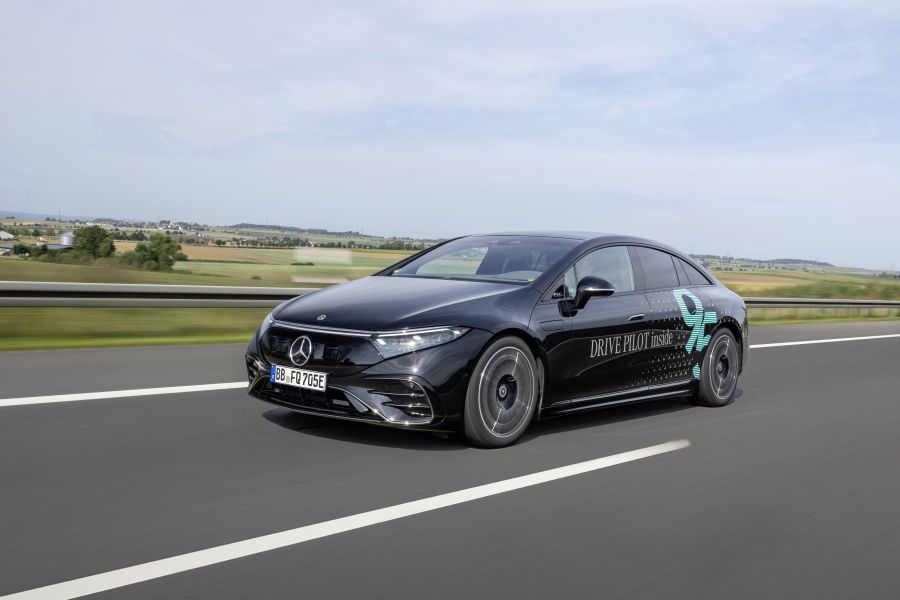Mercedes-Benz has updated its Drive Pilot automated driving system and has now received approval from the German Federal Authority for Motorized Transport. With this agreement, everything is ready for the next marketing in early 2025 in Germany. This update makes Drive Pilot the fastest system for conditional automated driving (SAE-Level 3) in a standard standard vehicle. It is available as an option on two ranges of luxury sedans – class S and EQS. The price of Drive Pilot remains unchanged (from 5,950 euros including tax). The cars equipped with Drive Pilot, which have already been built, receive the free update-either via the Internet (over-the-air-update), or during a visit to the workshop. There is no need to change the vehicle components for software update.
“With Mercedes-Benz’s innovative technologies, we always want to offer our customers added value. When Drive Pilot is activated, it is possible to focus on other things while the car supports driving. With the perfected version, which has now been certified by the German Federal Authority for Motorized Transport, this is also possible at 95 km/h in Germany under certain conditions. I am very proud that the fastest conditional automated driving system in the world comes from Mercedes-Benz. I am convinced that with our approach focused on security, we are on the right track to soon celebrate other milestones in automated driving. »»
Markus Schäfer, member of the board of directors of Mercedes-Benz Group AG, Director of Technology, Development and Purchasing
Thanks to this last upgrade, Drive Pilot can be used in fluid traffic up to 95 km/h under certain conditions on the entire German motorway network of 13,191 km. This allows customers to drive more frequently and longer in automated driving mode, while using their free time better. When Drive Pilot is activated, it is legally authorized for the driver to enjoy other activities, such as watching television or even watching a film in streaming via services such as the Ridevu application of Sony, read the newspaper (physically or via the MBUX system), work or simply relax while the car drives automatized under condition.
Redundant System Architecture for Security
Security remains the top priority for this update version of Drive Pilot. This is why the system has a redundant design, which means that important functions such as electricity, steering and braking are integrated into twice. If necessary, the system is still able to transfer the driving task to the person behind the steering wheel. If the driver fails to regain control even after an increasingly urgent incentive and the expiration of the management time (for example, due to a serious health problem), the system slows down the vehicle to the stop in controlled way while activating the distress lights. More than 35 sensors such as cameras, radars, ultrasonic sensors and Lidar (laser-radar) are used. These operate according to different physical principles and thus create redundancies for precise and real-time detection of the environment. From level 3 of the SAE, the use of the Lidar is essential for Mercedes-Benz for a safe automated driving. In combination with a very detailed GPS, a special positioning system allows Drive Pilot to know exactly on which highway lane the vehicle rolls, to the nearest a few centimeters.
The future of autonomous driving
The development of Mercedes-Benz continues in order to offer even more customers: higher speeds, longer driving times without driver intervention and even more comfort and safety. Road traffic will become safer as automated driving vehicles are on the roads. Currently, the legally authorized maximum speed for conditional automated driving in Germany is 130 km/h. Mercedes-Benz wants to reach this speed beach by the end of the decade.
Development also takes into account aspects that are not directly linked to automated driving technology: Mercedes-Benz is the world’s leading car manufacturer to develop special turquoise lights that indicate from the outside if Drive Pilot is active. This allows other road users to recognize a level 3 vehicle and feel comfortable if they see a driver who reads a book, for example. This should considerably improve the acceptance of driving vehicles automated by the public. This also allows the police and the police to identify the state of the system. Although the use of these “automated driving positions” has not yet been authorized in Germany, the feedback from the first series of trials in the United States is positive. At the end of 2023, the authorities of California and Nevada approved these “automated driving position fires” for test purposes or respectively for subsequent use in production vehicles.
Source link
Automobile Magazine

















